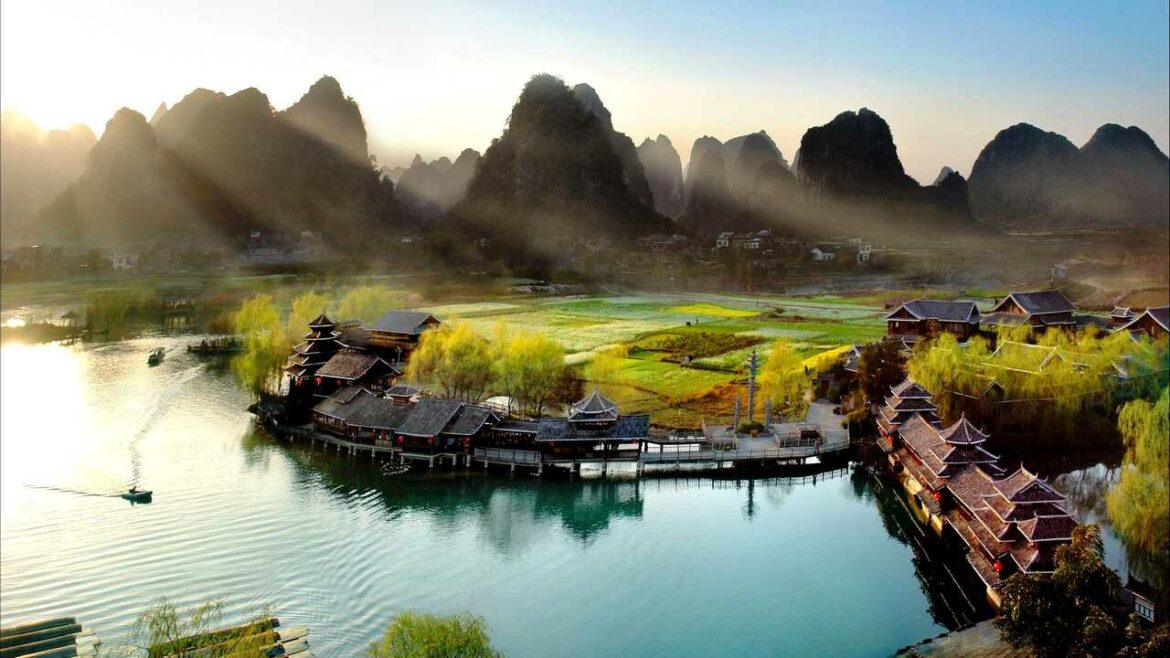South China is a region of stunning contrasts, where dramatic limestone peaks rise from emerald rivers, ancient villages preserve centuries-old customs, and vibrant cities blend tradition with modern life. For travelers seeking both natural beauty and cultural richness, South China offers an unforgettable experience.
The Landscapes of Dreams
One of the most iconic sights of South China is the karst scenery of Guilin and Yangshuo in Guangxi province. Towering limestone peaks, reflected in the Li River’s clear waters, have inspired Chinese poets and painters for centuries. A boat cruise from Guilin to Yangshuo reveals breathtaking panoramas at every turn, while cycling or hiking through the surrounding countryside allows visitors to see rice paddies, bamboo groves, and small farming villages up close.
The Longji Rice Terraces, also in Guangxi, are another highlight. Carved into the mountainsides by the Zhuang and Yao ethnic groups hundreds of years ago, the terraces change color with the seasons — golden in autumn, green in summer, and shimmering with water in spring.
Rich Cultural Mosaic
South China is home to a remarkable diversity of ethnic minorities, each with its own traditions, dress, and festivals. In Guizhou province, villages of the Miao and Dong peoples welcome visitors with wooden stilt houses, silver jewelry, and powerful polyphonic singing. Festivals such as the Miao New Year feature colorful dances, horse racing, and traditional food.
Yunnan province, bordering Southeast Asia, is perhaps the most diverse of all. With 25 recognized ethnic minorities, it offers a fascinating cultural mosaic. Ancient towns like Lijiang, with its cobbled lanes and canals, showcase the traditions of the Naxi people, while Dali reflects the Bai culture with its distinctive white architecture.
Natural Wonders of Yunnan
Yunnan is also a paradise for nature lovers. The Stone Forest (Shilin), with its dramatic limestone formations, is a UNESCO World Heritage Site. The province is home to snow-capped peaks like Meili Snow Mountain, highland lakes, and lush tropical forests. The Tiger Leaping Gorge, one of the deepest gorges in the world, offers thrilling hiking trails with views of the roaring Jinsha River, a tributary of the Yangtze.
For a taste of tropical China, the island of Hainan lies just off the southern coast. Known as “China’s Hawaii,” it boasts palm-lined beaches, luxury resorts, and hot springs. The city of Sanya is especially popular for winter escapes, with warm weather year-round.
Bustling Cities with Tradition
South China is not only about villages and landscapes — it is also home to dynamic cities. Guangzhou, the capital of Guangdong province, is a major hub of trade and innovation, famous for its Cantonese cuisine and skyscraper-studded skyline. Yet it also retains historic temples, traditional neighborhoods, and the charm of the Pearl River waterfront.
Nearby Shenzhen, once a fishing village, has transformed into a modern metropolis in just a few decades. Known for its tech industry, shopping, and theme parks, it also offers green parks and cultural attractions.
Hong Kong and Macau, though politically unique, are often included in journeys through South China. Hong Kong dazzles with its skyline, harbor views, and vibrant blend of East and West, while Macau enchants visitors with its Portuguese colonial architecture, lively nightlife, and world-famous cuisine.
A Culinary Paradise
Food is one of the greatest pleasures of traveling in South China. Cantonese cuisine, originating from Guangdong, is known worldwide for its delicate flavors and variety — from dim sum to roast duck and seafood dishes. In Guangxi and Yunnan, spicy and sour flavors dominate, often with influences from neighboring Southeast Asia. Street food, night markets, and small family-run restaurants provide endless opportunities to explore regional specialties.
Tea culture is also deeply rooted here. Yunnan is the birthplace of Pu-erh tea, a fermented tea prized for its unique taste and health benefits. Visiting a tea plantation or joining a traditional tea ceremony offers insight into one of China’s most cherished traditions.
Practical Tips for Travelers
Best time to visit: Spring (March–May) and autumn (September–November) offer pleasant weather, though Yunnan can be visited year-round due to its mild climate.
Getting around: High-speed trains and domestic flights connect major cities, while buses or private drivers are best for reaching rural areas.
Language: Mandarin is the official language, but Cantonese is common in Guangdong and Guangxi, while minority groups may speak their own dialects. English is spoken in major tourist areas, though learning a few Chinese phrases is useful.
Culture: Respect local customs in minority villages — ask before taking photos, and try to participate in local traditions with openness and curiosity.
South China is a land of endless variety — from the quiet beauty of rice terraces and mountain gorges to the bustle of global cities and the warmth of small village communities. It is a place where ancient traditions meet modern life, where every meal tells a story, and every landscape feels like a painting.
For travelers who want more than just sightseeing, South China offers something deeper: a chance to connect with people, culture, and nature in one of the most captivating corners of Asia.


